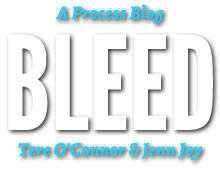We have developed BLEED as a way to record the process of constructing Tere’s next project. We invite you to read, to watch, to ask questions of our attempt to more transparently reveal the systems, values and thinking surrounding the making of these dances. We aspire to something more curious and seductive, even artistically promiscuous in its discursive reach. What might dance incite—aesthetically, politically, psychologically, linguistically, choreographically that extends outside the theatrical experience?
Tere explains the project below.
This project is an expanded manifestation of the ways I have always worked. I don’t start with any strong thematic ideas. I begin from day one to make material as a way of thinking and sensing ideas. I develop material from multiple unrelated sources down divergent pathways as a way of entering the realm of consciousness where nothing aspires to order. I then bring these ideas/materials together by placing them in close temporal proximity. A splintering journey begins through this assemblage. Eventually, a decidedly choreographic alchemy commences and alters the singular attributes of each element as they begin to act upon each other. Abstraction becomes a distinct idea becomes a musical reverie becomes an emotional circuitry becomes a clear idea becomes nothing…but becomes is the important word. Finally, through the entanglement of these disparate elements I shape a new construction in shared imaginative space. I am replicating this process in this new project by creating different works and then merging them into a final iteration.
Over the next two years, I will make three distinct dances with totally different casts and points of departure and then collapse these into each other to create a fourth dance. I have identified and separated out three strains of my thinking as catalysts for each work. These elements, always entwined in my dances will then be remixed into the fourth work.
Dance 1: Mentorship, relationship, improvisation
Dance 2: Artifice, formalism, complexity
Dance 3: Sameness and otherness
Dance 1 I have taught and mentored many emerging artists. Drawing on the impact of the relationships I have had with students and artists I have mentored over the last 30 years, this dance focuses on how these interactions have shifted my thinking. The effects of these myriad relationships have become deeply integrated into my making. Dance 1 was constructed as a collaborative process with the performers Mary Read, Devynn Emory, Tess Dworman and Ryan Kelly using improvisational techniques. I include the individual nature of each dancer —both fictionalized by me and actualized by them—allowing them to be the primary material for the work. The generational difference is both exhilarating and rife with inevitable distances. The piece plays with redefinitions of authorship by giving the performer’s choreographic agency, making on-the-spot decisions that shift my own and alter the work each night. These people are all very clear, wonderful artists and they understand where their artistic affinities reside. They all create their own work and come from very different backgrounds. Dance 1 was performed as a work-in-progress at the River to River festival in NYC in July 2012 and as part of the Anti-Establishment show at the Center for Curatorial studies at Bard College,
Dance 2 This work is based on my unwavering affinities with more formal, crafted,artifice-oriented elements of dance making. Although eschewed by many choreographers at this moment, I don’t feel these aspects have even begun to be exploited as the truly transcendent components of dance that they are. I am working with a different group of amazing performers whose extraordinary abilities internally transform the fixity of the choreography into a fluid vehicle for individual expressions. They are Natalie Green, Michael Ingle, Heather Olson, Silas Riener, Natalie Green and Oisin Monaghan. I will re-embrace design and incorporate the technically driven body back into my work in addition to the range of embodiments I normally explore. In some ways this piece hearkens back to my earlier work. Please see the process notes area to hear more. Dance 2 will be performed together with Dance 1 at New York Live Arts Nov 27 – Dec 1 at 7:30pm, Nov 30 at 10pm http://newyorklivearts.org/event/2-new-works
Dance 3 In this work I will be looking at sameness and difference in co-existence. I am very pleased to create a duet for the amazing Cynthia Oliver and David Thomson. They are two longtime friends and colleagues with whom I share a common community and at the same time diverse racial, professional and stylistic experiences. Just as Dance 1 and Dance 2 reveal sameness inside of difference this dance will braid these two ideas together. I will create this dance in May-June of 2013 and it will have its premiere at the Krannert Art Museum at the University of Illinois in Urbana where I am a professor, as is the esteemed Dr. Oliver.
Dance 4 Will be a final iteration of this series as the first three works become material for the fourth. They may be completely altered or reiterated or, or, or… The work will be presented in New York City in late fall of 2013 at a theater TBA.

It is wonderful that the clear-cut boundaries between theory and art-making are being destabilized in such a poetic, skillful manner. I am really excited about witnessing the development of this collaboration. When Tere writes about the formal aspects of art making as being shun by many contemporary authors I am propelled to ask few open-ended questions. What kind of relationships can artists’ actively working in today’s society have to the history (I am thinking primarily of the history of ideas and ideological constructs) of separation between form and content, outside and inside, natural and artificial? How do we see art aesthetically , how much formalism in this day and age is really our attempt to perceive organized patterns, and is so-called authentic contingent on the existential desire to have moments of pure experience?